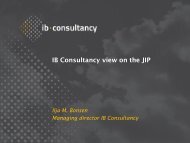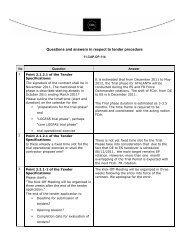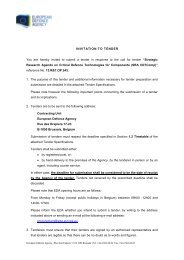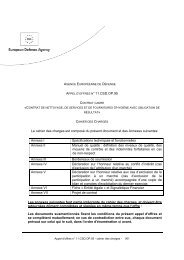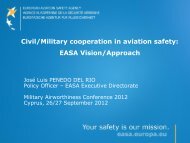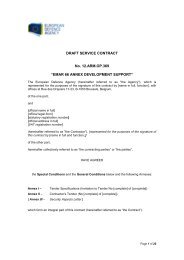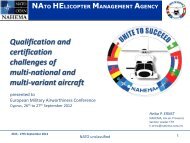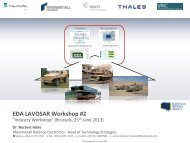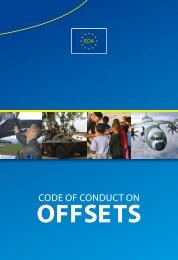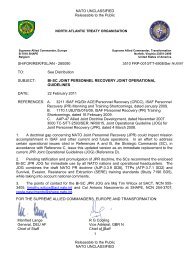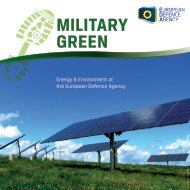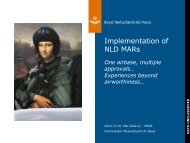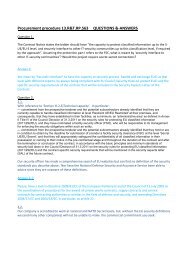capability development plan - European Defence Agency - Europa
capability development plan - European Defence Agency - Europa
capability development plan - European Defence Agency - Europa
You also want an ePaper? Increase the reach of your titles
YUMPU automatically turns print PDFs into web optimized ePapers that Google loves.
THREATS AND CHALLENGES DERIVING FROM<br />
POTENTIAL ADVERSARIES<br />
Evolution of threats<br />
Conflicts during the Cold War can be characterized by smaller-scale conventional wars, insurgency<br />
campaigns and counter-insurgency operations - a representation of armed conflict in a modern world.<br />
They can also be characterized by the relative restraint shown by the superpowers in the sort of wars<br />
they fought - avoiding escalation into total war which had been experienced between 1914 and 1945.<br />
They even pressurised allies to end fighting because of concern that it may intensify and draw them<br />
into the conflict on opposing sides (1973 Arab-Israeli War). Indeed, the outcomes in Korea, Vietnam<br />
and Afghanistan (Soviet intervention) demonstrated how countries were willing to limit their effort in<br />
terms of available weaponry, geographic scope and objectives pursued.<br />
The end of the Cold War was followed by a number of wars in Europe and Africa employing relatively<br />
low-tech weaponry but which were brutal in nature with heavy death tolls. It seemed that this savage,<br />
novel form of conflict would typify the post-Cold War, postmodern period but reality was to be far more<br />
complex. The globalised architecture of world order changed and with it, the associated custom of<br />
armed conflict. Adversaries in the modern era were fought by formally organised, hierarchically<br />
structured forces of the state. In post-modern era armed conflict there has been a dispersal of control<br />
of this organised violence to many forms of non-state actors. A disparate array of informal, stateless<br />
forces including guerrilla armies, kin/clan/tribal-based irregular forces and paramilitary groups nurtured<br />
by criminally funded warlords, national armies and de-territorialised terrorists’ networks. Although<br />
irregular in their form, their objectives are usually as political as those of states themselves.<br />
Given the tragedy of 9/11 and the consequent operations in Afghanistan and Iraq, and the multitude of<br />
conflicts that have and are occurring globally, it is imperative that the EU considers a generic threat<br />
assessment for its strategic future military <strong>plan</strong>ning. This would enable Member States to structure and<br />
train their future forces accordingly, utilising comprehensive, end-to-end <strong>capability</strong>-based processes.<br />
Indeed, a lack of attention to detail on threat often leads to a misinterpretation of what the objectives<br />
are in a capabilities-based approach. For instance, improving what we have and hope that it will suffice<br />
to defeat the future threats is likely to support current <strong>plan</strong>s but does not necessarily support the<br />
<strong>development</strong> of new capabilities to tackle new threats. The CDP aims to address this possible<br />
shortcoming.<br />
There are many potential regularly-structured adversaries that maintain large conventional forces and<br />
can be potentially associated with a regional conflict. Currently, the <strong>capability</strong> gap between them and a<br />
<strong>European</strong> coalition is significant but Workshop B illustrated how this may close towards 2020-2025. By<br />
2025 these potential adversaries may well have access to cruise missiles, vast number of tube and<br />
guided rocket artillery pieces, small long-range missile boats, submarines and 4th generation aircraft.<br />
Additionally, some may be able to mobilise massed manpower if the operation is within or adjacent to<br />
their borders - quantity can be a quality of its own. But, perhaps more importantly, many rising powers<br />
are demonstrating a willingness to employ a new generational concept of armed conflict rather than<br />
just to try and overcome their oppositions lead in a past era of military strategy.<br />
This latter quality can also be associated with current insurgency approaches. Hard to detect, based<br />
upon a broad ideology, with a novel structure and robust capacity to regenerate, they cut across ethnic,<br />
class and national boundaries and adhere to no specific rule book. Comprised of a network of groups<br />
they are extremely difficult to target or decapitate, learning quickly to withdraw, adapt and be patient for<br />
a prolonged struggle where they will confront the enemy on their terms. Not only networked in<br />
leadership, they will be able to make extensive use of networked organisations - political, social, and<br />
financial, whether legitimate or not. They will be unpredictable and determined, and capable of causing<br />
great destruction and death - without scruple, requiring enormous resources to be spent on protection<br />
by countries that are notably risk and casualty adverse.<br />
However, the reality is more likely to be a combination of the shades of black and white portrayed<br />
above. Potential adversaries will have considered the implications of directly challenging EU Member<br />
States’ conventional forces. They are very unlikely to seek conventional superiority but rather will look<br />
for ways to use networks, alliances and human ingenuity to overcome a perceived EU technological<br />
lead. They will seek to be as asymmetric as they can. Emphasis may be on urban guerrilla fighting as<br />
much as cyber warfare, information attacks, financial terrorism or the unrestricted use of military and<br />
non-military means. By using conventional forces but in ways that are ethically unacceptable to<br />
western standards, they could attempt to achieve a profitable combination to achieve their objectives,<br />
avoiding a needless definition of their centres of gravity but focussing on the EU’s, limiting our access<br />
and ability to concentrate forces and effects. The use of proxy forces and disruption techniques would<br />
further exacerbate the EU’s problems of dislocation.<br />
So this could be the sort of adversaries that EU Member States’ forces could face; firstly regularstructured<br />
forces relying upon conventional concepts or adapting in light of lessons from current<br />
operations, modern defence-thinking and their brand of comprehensive <strong>plan</strong>ning. Next, there could be<br />
sophisticated irregular adversaries, insurgents or non-state actors that grasp a clearer and, perhaps,<br />
deeper understanding of 4th generation warfighting. And finally, EU Member States forces may face a<br />
civil war or conflict associated with the collapse of a failed state where brutality and attrition is the<br />
adversary’s only tactic to rule a given territory. Despite the passage of time, such analysis tends to<br />
confirm that the character of warfighting may change but not the nature of armed conflict.<br />
51<br />
FUTURE TRENDS FROM THE CAPABILITY DEVELOPMENT PLAN



